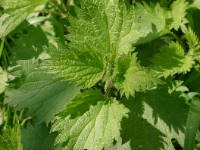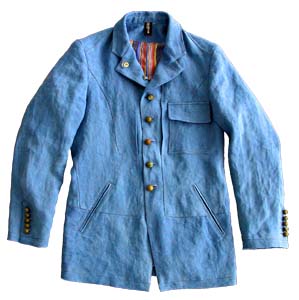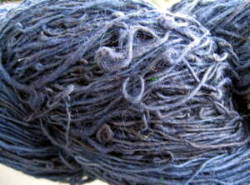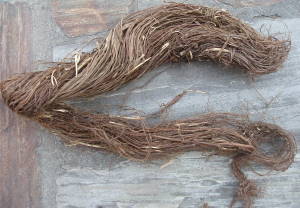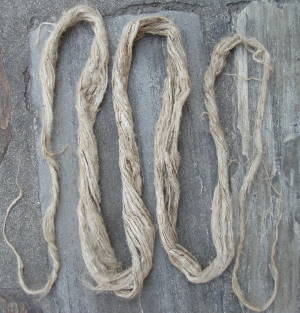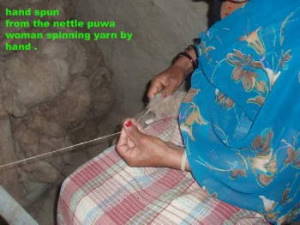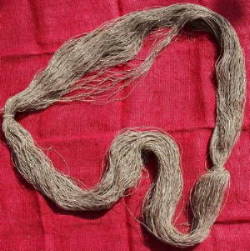Background
information
A heavy nettle hero
If Professor Ray Harwood has his
way, we'll all be wearing T-shirts and bikinis made from stinging
nettles.
When Ray Harwood toils in his Leicestershire
allotment, he takes particular care with his nettles. Despite risking multiple
stinging and abrasions, he tends to them as though they are rare orchids. "Everybody there laughs at me when I'm weeding my nettles," he
says as he picks the burrs from his trousers, the result of a recent session.
"They think it's just a weed. But they're worth their weight in
gold."
Harwood believes that the future lies in the common stinging nettle, urtica
dioica. As professor of the textile engineering and materials research
group at Leicester's De Montfort University, he is involved in the first
contemporary British project to develop nettles as a fabric. It's called Sting
- Sustainable Technologies in Nettle Growing - and was started in 2004 with funding from the Department of Environment Food and Rural Affairs (Defra)
and its agent, the Central Science Laboratory (CSL). If his work proves
successful, we may all be wearing nettle T-shirts in ten years' time.
The name was coined by Harwood's colleague and soon-to-be wife Jane Wyatt.
"I love a nice acronym," says Wyatt, who clearly has some publicity
nous, unlike her fiancÚ who prefers a more sober approach. As Harwood
repeatedly insists, his is a serious project that concerns a good deal more
than "gimmicky fashion items". Which is, of course, exactly how nettle fabric has been marketed so far.
The same year the Italian fashion house Corpo Nova introduced various
nettle-related products, including jeans with nettle yarn that were a huge hit
at Selfridges. Japanese fashion buyers have bought all the nettle yarn they
can find. And even Harwood's own department has played its part in the stinger
vogue; Wyatt's student Alex Dear produced (and subsequently modeled) a pink
bikini made of nettle fabric.
Harwood doesn't want nettle fashion to be just a flash in the pan.
"The point is that nettles have to be made into a commodity," he
says. "Fashion gimmicks don't employ people." He also believes that
nettles could represent work as well as textiles, and could help revive
Britain's rural economy.
"I was skeptical about nettles at first," he says. But his
interest grew in the mid-1990s when his team started the revive the use of
flax and hemp. "No one's got hemp to the quality we've made," says
Harwood, holding up a great bundle of the stuff, "but it's difficult to
regulate its growth." Unlike nettles, which are already well established
as a viable, and legal, cash crop. Nettle soup is a hedgerow treat, while
Cornish Yarg cheese is one of several that come wrapped in dried nettles. A
delicious nettle tortellini is available in Italy. And that's not counting
nettle teas and cordials; wines and beers; shampoos and conditioners.
The stinger is becoming known as a bit of a wonder plant, and has been used
to treat prostate disease, allergies and arthritis. There's even a national
"Be Nice to Nettles" week. At this point I have to ask the billion
dollar question: how do they get rid of the sting? Harwood replies with the
air of someone for whom this particular enquiry grew tiresome years ago.
"You cut them and dehydrate them, the pressure goes, so there's no
sting." So, you can wear your nettle underpants without fear. Instead,
Harwood wants to talk about the potential of nettle fabric as a commodity,
and, most importantly, the size of the plant - an interest inspired by
Interface Fabrics, a company that produces industrial chair coverings.
"The taller the nettle, the stronger the fiber," says Harwood.
I try to imagine a field full of stingers waving in the breeze: bushy
deep-green plants six or seven feet high, planted in rows a couple of feet
apart and attractive to wildlife such as butterflies and voles. Apparently,
there's already a willing army of farmers ready to turn their land over to the
stinger. Harwood says that he has two lined up already, and at the Royal Show
received enquiries from another 20 who were all looking for something
different to grow. "Farmers are very inquisitive, but what they need is a
consistent nettle - hardy, tall-growing, perennial," says Sting's
research fellow, the plant scientist Russell Sharp.
So why do we need nettle cloth at all? The research is part of a long-term
investigation by the European Union into alternative crops that farmers can
grow to stop them overproducing food. "Nettles grow in most parts of
Europe," says Harwood. "They hate drought so they will grow in rainy
areas that aren't suitable for other crops, such as western Scotland."
Harwood adds that the desire to explore the worth of nettles is also driven by
the world's over-reliance on cotton. "At the moment we produce about 20
million tons of fiber a year and 18 million tons of it is cotton," he
says. "It needs special hot conditions and comes from countries such as
India, Pakistan, China and Sudan. Cotton is still the most worn fiber in the
world and global demand is increasing, particularly in the developing
countries." But cotton is not environmentally friendly (despite being a
natural fiber). Its cultivation accounts for 20 per cent of the world's
pesticides, and also uses chemicals that arise from oil production. "And
as we know, oil is becoming more expensive," he adds.
Nettle wear is therefore a greener option, and has something of a history.
Before the 1660s cotton wasn't used in great quantities. Flax and wool were
the main textiles, and nettles were an alternative. "There's a lot of
anecdotal evidence about wild nettles being used," says Wyatt. "For
instance, Elizabeth I slept in a 'nettle bed', which we think means the
textile covering rather than the stuffing." Napoleon's army is thought to
have been clad in nettles, and the plant was frequently used to make
tablecloths and sheets in Scotland, where the term "nettle cloth"
became a catch-all term for any fine material.
However, the nettle's finest hour arrived during the First World War.
"Britain and the US controlled the whole of the cotton industry,"
says Harwood. "We didn't supply the Germans, so there's some evidence
that they used nettles for making things such as sandbags, straps, rucksacks
and harnesses." The same thing happened during the Second World War, when
cotton shortages saw nettles used to make parachutes.
Sting has already looked into the research conducted at the Botanic
Institute in Hamburg by Herr Beidermann, the father of modern nettle
cultivation, between the 1920s and the 1950s. His work was continued by a
successor called Gisela Presling, who retired this year. Alas, she has not yet
shared her nettle know-how.
|



